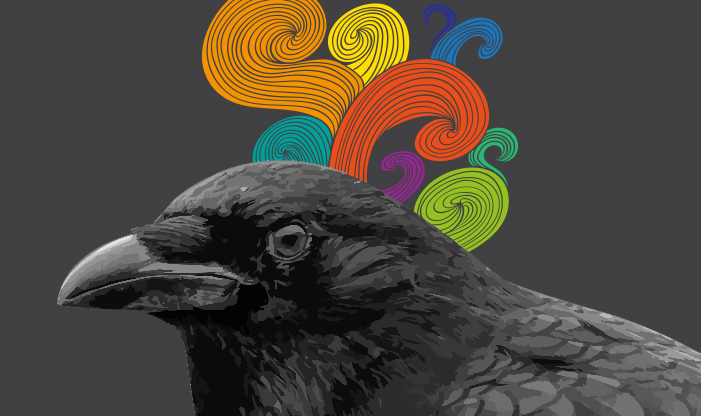When you hear a loud, hoarse “Caw!” sounding outside, you probably recognize it as the call of a crow. What you might not know is how playful, social, and intelligent these animals are. Crows are family-oriented beings who have surprising communication abilities. They are highly organized creatures who have unique methods of finding food. Despite all we know about them, there is still a lot to learn from crows.
A Variety of Local Habitats
Here in Wisconsin, American Crows are a common feature of our landscape. Their corvid relatives, blue jays and ravens, are also native. In Milwaukee, the large black birds you can see are crows, while ravens are found in the northern part of the state, standing twice as large as crows. Crows inhabit a variety of habitats, from urban to rural, including open fields, vacant lots, town centers, and empty beaches. They build large stick nests toward the top third of a tree, preferably an evergreen, usually 6-19 inches across. They often use an old raptor nest. The clutch is between three and nine eggs. To avoid predators, these often noisy birds will fall completely silent as they fly to the nest, so as to not give away its location.
Social Dynamics
Crows lead dynamic and complex lives. They live in family groups, just like we do, with two parents, this year’s chicks, and offspring from previous years. The older young will help raise the next generation with their parents. Some families may consist of up to 15 birds.
Every fall, the family groups from many nearby areas will congregate in large numbers for the winter months, creating massive flocks of crows. The crows sleep in communal roosts during the winter, which consist of dozens to a few hundred birds. It is not uncommon for an entire street block to become a foraging place, each yard covered in crows as they search for their last meal of the day before heading to roost.
Opportunistic Diet
Crows are omnivores, feeding on nearly anything they can find: seeds, fruits, small mammals, carrion, and occasional food scraps they find in parking lots. They may also rob chicks from nests, and steal food from other animals.
Crows have been spotted following mergansers to steal the minnows the ducks were chasing. They also use their social groups to aide in safe foraging. As members of the family are on the ground searching, there is always a sentinel bird high in the trees on the lookout. Next time you see crows on the ground, look up to spot the guard.
Studies have shown that the crow brain is highly developed for social living. In fact, they have one of the largest brains proportional to their body size. Crow language is evolved enough that each member of the family has a name. They also have the ability to mimic, exhibiting the sounds of car alarms, trucks reversing, and even copying the sounds of predators to scare away others. It’s been suggested that they communicate with each other about sources of food or areas to avoid. Crows also use facial recognition, meaning they can identify individuals, even when they’re human.
In 2002, West Nile Virus spread through Wisconsin and decimated our crow populations. These birds are extremely susceptible to this mosquito-borne illness and their numbers fell drastically. Since then, they have rebounded.
At Schlitz Audubon, our resident crow, Loki, works tirelessly to teach everyone about the amazing lives of crows. To show how smart they are, Loki recycles, paints and even takes donations to support the Raptor Program. We encourage you to take a moment the next time you come across a crow and observe them.


